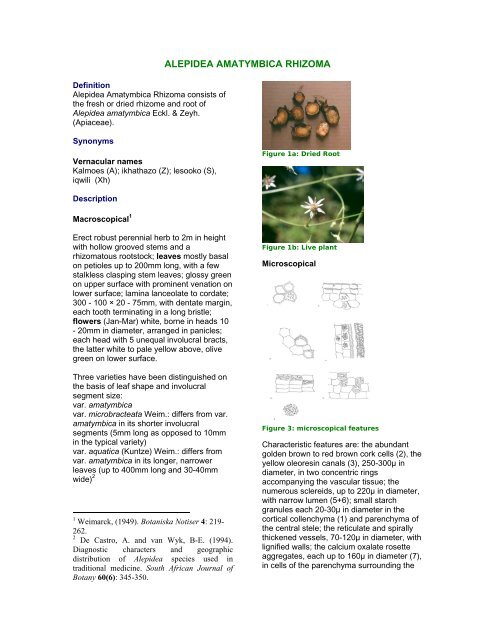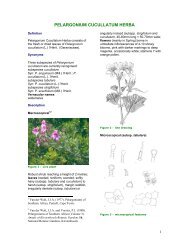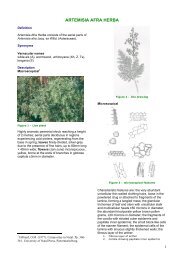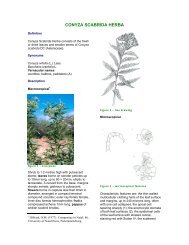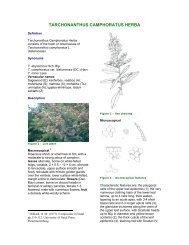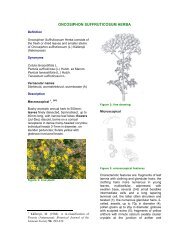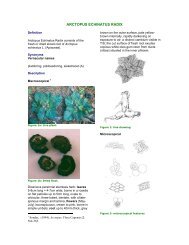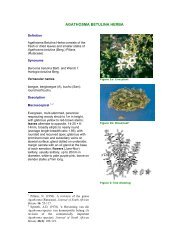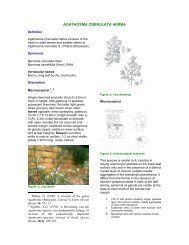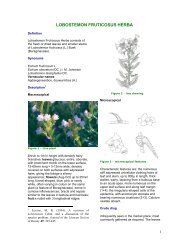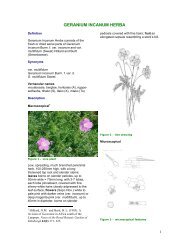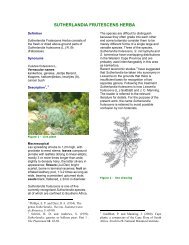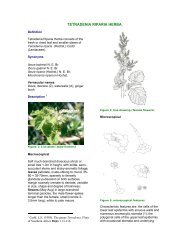RHIZOMA ALEPIDEA AMATYMBICA - PlantZAfrica
RHIZOMA ALEPIDEA AMATYMBICA - PlantZAfrica
RHIZOMA ALEPIDEA AMATYMBICA - PlantZAfrica
You also want an ePaper? Increase the reach of your titles
YUMPU automatically turns print PDFs into web optimized ePapers that Google loves.
Definition<br />
Alepidea Amatymbica Rhizoma consists of<br />
the fresh or dried rhizome and root of<br />
Alepidea amatymbica Eckl. & Zeyh.<br />
(Apiaceae).<br />
Synonyms<br />
Vernacular names<br />
Kalmoes (A); ikhathazo (Z); lesooko (S),<br />
iqwili (Xh)<br />
Description<br />
Macroscopical 1<br />
Erect robust perennial herb to 2m in height<br />
with hollow grooved stems and a<br />
rhizomatous rootstock; leaves mostly basal<br />
on petioles up to 200mm long, with a few<br />
stalkless clasping stem leaves; glossy green<br />
on upper surface with prominent venation on<br />
lower surface; lamina lanceolate to cordate;<br />
300 - 100 × 20 - 75mm, with dentate margin,<br />
each tooth terminating in a long bristle;<br />
flowers (Jan-Mar) white, borne in heads 10<br />
- 20mm in diameter, arranged in panicles;<br />
each head with 5 unequal involucral bracts,<br />
the latter white to pale yellow above, olive<br />
green on lower surface.<br />
Three varieties have been distinguished on<br />
the basis of leaf shape and involucral<br />
segment size:<br />
var. amatymbica<br />
var. microbracteata Weim.: differs from var.<br />
amatymbica in its shorter involucral<br />
segments (5mm long as opposed to 10mm<br />
in the typical variety)<br />
var. aquatica (Kuntze) Weim.: differs from<br />
var. amatymbica in its longer, narrower<br />
leaves (up to 400mm long and 30-40mm<br />
wide) 2<br />
1<br />
Weimarck, (1949). Botaniska Notiser 4: 219-<br />
262.<br />
2<br />
De Castro, A. and van Wyk, B-E. (1994).<br />
Diagnostic characters and geographic<br />
distribution of Alepidea species used in<br />
traditional medicine. South African Journal of<br />
Botany 60(6): 345-350.<br />
<strong>ALEPIDEA</strong> <strong>AMATYMBICA</strong> <strong>RHIZOMA</strong><br />
Figure 1a: Dried Root<br />
Figure 1b: Live plant<br />
Microscopical<br />
Figure 3: microscopical features<br />
Characteristic features are: the abundant<br />
golden brown to red brown cork cells (2), the<br />
yellow oleoresin canals (3), 250-300µ in<br />
diameter, in two concentric rings<br />
accompanying the vascular tissue; the<br />
numerous sclereids, up to 220µ in diameter,<br />
with narrow lumen (5+6); small starch<br />
granules each 20-30µ in diameter in the<br />
cortical collenchyma (1) and parenchyma of<br />
the central stele; the reticulate and spirally<br />
thickened vessels, 70-120µ in diameter, with<br />
lignified walls; the calcium oxalate rosette<br />
aggregates, each up to 160µ in diameter (7),<br />
in cells of the parenchyma surrounding the
vascular tissue and oleoresin ducts, forming<br />
an incomplete crystal sheath (4).<br />
Crude drug<br />
The fresh rhizome is russet-brown externally<br />
with adhering roots; the cut surface shows<br />
two rings of oleoresin ducts in a matrix of<br />
pale yellow ground tissue; odour pleasant<br />
aromatic, texture crisp resinous when fresh;<br />
f racture sharp when dry.<br />
Geographical distribution<br />
Locally common in grassland of the northern<br />
and southern Drakensberg mountains of the<br />
Eastern Cape Province, Lesotho, Kwazulu-<br />
Natal, Swaziland, Mpumalanga and<br />
Northern Province; also northwards into<br />
Zimbabwe, on streambanks, drainage lines<br />
and forest margins between 850-2500m.<br />
Var. amatymbica is widespread but var.<br />
aquatica is recorded only from the Eastern<br />
Cape Province between Somerset East and<br />
Cala, and var. microbracteata only from the<br />
Umzinto region of southern Kwazulu/Natal 1 .<br />
Recent work suggests however that only two<br />
forms of Alepidea amatymbica are<br />
distinguishable: a typical form from the<br />
Eastern Cape with leaves tapering toward<br />
the base and a northern form with cordate<br />
leaves 2 .<br />
Figure 4: distribution map<br />
Quality standards<br />
Identity tests<br />
Thin layer chromatography on silica gel<br />
using as solvent a mixture of toluene:diethyl<br />
ether:1.75M acetic acid (1:1:1). Reference<br />
compound cineole (0,1% in chloroform).<br />
Method according to Appendix 2a.<br />
Only one collection of this species was<br />
available for TLC assessment. Further work<br />
is required.<br />
HPLC on C18 column, method according to<br />
Appendix 2b.<br />
Major compounds:<br />
Methanol extract:<br />
Retention times (mins): 5.67; 6.93<br />
Figure 6: HPLC spectrum<br />
Purity tests<br />
Assay<br />
Not yet available<br />
Major chemical constituents<br />
This species has been shown to contain a<br />
mixture of several kaurene-type diterpenes<br />
such as ent-16-kaurene-19-oic acid (see a<br />
below) 3 , which may together constitute up to<br />
11.8% of rhizome and root dry mass 4 . Very<br />
similar compounds occur in Arctopus<br />
echinatus (Apiaceae), also used in<br />
traditional medical practice.<br />
3 Rustaiyan, A. and Sadjadji, A.S. (1987).<br />
Kaurene derivatives from Alepidea amatynsia<br />
(sic). Phytochemistry 26(7): 2106-2107.<br />
4 Holzapfel, C.W., van Wyk, B-E., de Castro, A.,<br />
Marais, W. and Herbst, M. (1995). A<br />
chemotaxonomic survey of kaurene derivatives<br />
in the genus Alepidea (Apiaceae). Biochemical<br />
Systematics and Ecology 23(7/8): 799-803.
Figure 7: chemical constituents<br />
Dosage forms<br />
Fresh or cooked rhizome and roots are<br />
chewed or sucked and dried powdered drug<br />
used as a snuff. Smoke from burning dry<br />
material is inhaled and a root infusion taken<br />
orally or administered per rectum as an<br />
enema. Fresh rhizome is applied externally<br />
GR1, 12, 28<br />
as a styptic.<br />
Medicinal uses<br />
This species is highly regarded as a remedy<br />
for respiratory tract infections, asthma, sore<br />
throat, gastro-intestinal complaints, fever,<br />
rheumatism, bleeding wounds and<br />
headache.<br />
Pharmacology/bioactivity<br />
Preliminary in vivo assays (animals) have<br />
demonstrated antimicrobial,<br />
GR12. .<br />
antihypertensive and diuretic activity<br />
In vitro vasorelaxation (rat aorta; dose<br />
0,1mg/ml) and in vivo diuretic activity (IG;<br />
rat; dose 50.0mg/kg) have been<br />
demonstrated for hexane/ethyl acetate<br />
extracts of fresh rhizome 5<br />
The results of an investigation of cytotoxicity<br />
and antiviral activity of 16 South African<br />
plant species 6 showed that aqueous<br />
extracts of Alepidea amatymbica were not<br />
cytotoxic, at any concentration used in the<br />
test, to HeLa, Vero, Jurkat E6.1, AA-2 or<br />
CEM-SS cells. Similar extracts were found<br />
to reduce the infectivity of both Coxsackie<br />
B2 virus and HSV-1, at most dilutions used.<br />
In a cell culture antiviral assay, aqueous<br />
extracts did not inhibit replication of HSV-1<br />
but inhibited that of Cocksackie B2 virus at<br />
the higher concentrations tested.<br />
5 Somova, L.I., Shode, F.O., Moodley, K. and<br />
Govender, Y. (2001). Cardiovascular and<br />
diuretic activity of kaurene derivatives of<br />
Xylopia aethiopica and Alepidea amatymbica.<br />
Journal of Ethnopharmacology 77(2/3): 165-<br />
174.<br />
6 Treurnicht, F. T. (1997). An evaluation of the<br />
toxic and potential antiviral effects of some<br />
plants used by South Africans for medicinal<br />
purposes. MSc thesis, University of<br />
Stellenbosch.<br />
Contraindications<br />
None known<br />
Adverse reactions<br />
None recorded<br />
Precautions<br />
No special precautions<br />
Dosage<br />
For respiratory complaints (cough, cold,<br />
influenza), the recommended adult dose is<br />
one tablespoonful of raw or cooked rhizome<br />
and root; for children one to two<br />
teaspoonsful, according to age, is sufficient<br />
GR12 .<br />
Copyright in this monograph resides with the authors, the South<br />
African National Biodiversity Institute, the South African Medical<br />
Research Council and the University of the Western Cape. It may<br />
not be reproduced in whole or in part without the written consent of<br />
the copyright holders.


